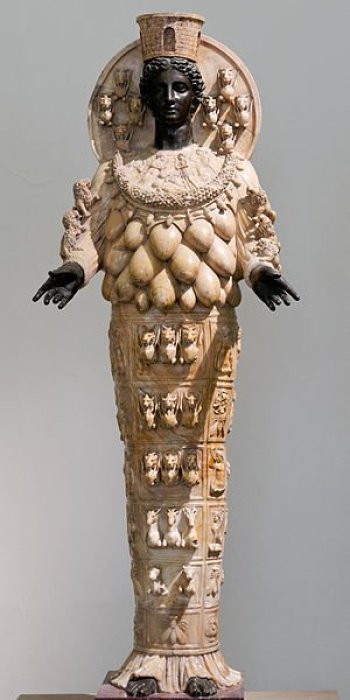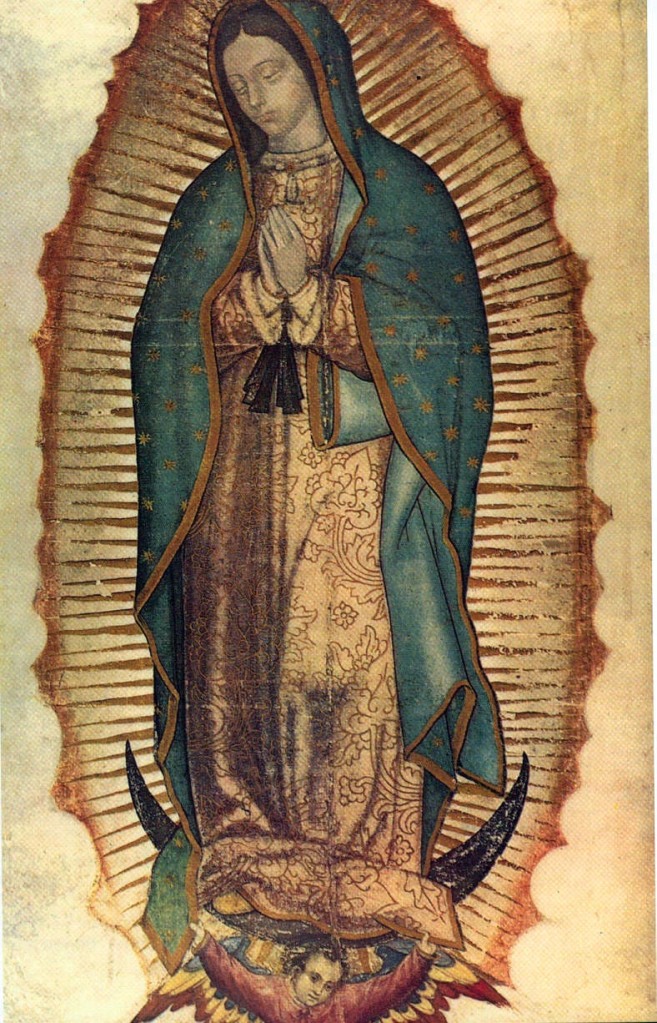
“There is a grave aura about many of the Black Virgins, an expression of utter solitude so intense that the child on her knees or in the embrace of her left arm seems strangely appended. She sits, solitary, weighted, at the crossing-over place, the place where we fall, face down, and do obeisance. Rooted in her own aboriginal darkness, her eyes are opaque, blank, veiled in the deepest interiority. She sits deeply, a curtained container, a tabernacle, the eternally bloody cave of birth, disintegration, and rebirth. Sedes sapientiae. Seat of Wisdom.”
Meinrad Craighead, “Lodestone,” in The Moonlit Path: Reflections on the Dark Feminine, edited by Fred Gustafson, 2003, p. 79
Apophatic or negative theology teaches that the divine is ultimately unknowable and inexpressible in words. Standing face to face with the Black Madonna is an experience beyond words. What follows is perhaps a futile attempt to grasp at that mystery, which, I have come to realize, has become my personal Holy Grail.
The dark feminine is the divine face for our times. Her darkness needs to be juxtaposed with our deluded age of Enlightenment. We can see her as the angry Mother Nature and we can feel her fury as she emerges from the shadows determined not to take any more abuse. She stands firmly on the side of the excluded and the forgotten. Our Lady Aparecida, the Black Virgin patroness of Brazil, appeared to poor fishermen who found her in her nets. According to a legend, she was white before she fell into the river:
“Legend holds that the river turned the Virgin black. In the river she lay broken, on the bottom, like the people whom the Portuguese had enslaved and colonized, until the fishermen found her and made her their own.”
China Galland, “Raise up Those Held Down: A Pilgrimage to the Black Madonna, Mother of the Excluded, Aparecida, Brazil, in: The Moonlit Path: Reflections on the Dark Feminine, edited by Fred Gustafson, 2003, p. 216

Some Black Madonna lore tells of the statue changing the colour gradually from white to black, but most icons have been black since the beginning. This speaks to the Dark Virgin’s power of instigating the alchemical process – she presides over the nigredo, during which the inessential and the insubstantial falls off, rots, putrefies. She is the Queen of Transmutation:
“From the perspective of the ego, they are lethal forces. But without yielding to this composting and transcendent energy, no transformation is possible and therefore no renewal of life-force. As archetypal energies within the psyche, what these personages accomplish is the breaking down and transmutation of toxic substances, thereby fueling soul growth.”
Cedrus N. Monte, “At the Threshold of Psycho-Genesis/The Mournful Face of God”, in: The Moonlit Path: Reflections on the Dark Feminine, edited by Fred Gustafson, 2003, p. 16

From this heap of compost new life force arises. What has been lost in the long age of patriarchy is returning. A new balance of forces is hopefully emerging. A world where the default human is not only a white male. The Black Madonna is at the symbolic centre of these changes. Arguably, she is the most ecumenical figure in Christianity. She may be able to bring together all faiths of the past and present. So much has been projected on her – she is the dark pagan goddess, she is Isis, the Throne of Wisdom, she is the dark Demeter, Artemis of Ephesus, Cybele, she is Mary – mother of God, she is Mary Magdalene – a female apostle and consort of Jesus Christ, she is “the black but beautiful” Shulamite from the Songs of Songs, she is the Queen Sheba, she is The Holy Grail and the Ark of Covenant sought by the Knights Templar in the Holy Land, she is the primordial African mother of the whole human race. She is the dark meteorite and the black Kaaba Stone from Mecca. She is Kali and the Black Tara.

The mystery of her blackness has been explained by a plethora of extraordinary researchers. Is her blackness symbolic, as Jungian researchers insist, or is she black because she is the dark African mother, the primordial mother goddess such as Isis? The latter theory has been proposed by Chiavola Birnbaum. The former always revolves around the idea of blackness as the void, the primordial matter and earth that is both the fertile womb and the ultimate tomb. We come from her and we return to her. Like Kali, whose name is connected with Time, she is both the origin and the end. Like the colour black, she assimilates all into herself. I especially resonated with these words of Ella Rozett, the curator of the ultimate online resource on the Black Madonna:
“Shortly after I was asked for the first time to give a talk on the black Madonnas I was able to go to Loreto, Italy before the black Mother in the darkness of her little brick house. There I asked her directly about the meaning of her blackness. Listening with an empty, open mind and with my whole being, I felt that she was covering me with the darkness of her cloak as in a dark ‘cloud of unknowing’. In that darkness beyond words we communed. She did not give me any words then, but afterwards I felt assured that she reveals her secrets to those who love her. Those who dare enter the darkness of the ‘Cloud of Unknowing’ and the ‘dark night of the soul’ (St. John of the Cross) she draws into herself, like a ‘black hole’ draws in matter, and there, in that darkness, she teaches them. It’s like being in the womb of God: you know you are safely held and nourished. You grow without needing to understand how. Ever since then, I see Black Madonnas as a symbol for the womb of God.”

The same Ella Rozett writes this about the image of the famous Madonna of Guadalupe:
“The image of Our Lady of Guadalupe reveals her dark and light side in two ways: one, she radiates with the light of the sun, while standing on a dark moon, and two, a straight line runs down the middle of her dress, dividing it into a light and a dark side.”

Thus she brings wholeness to the one-sided world, restoring a much needed balance. In a mysterious way she does not obliterate diversity but affirms it. Everyone and everything is covered by her mantle: she is the mother who does not exclude. In her black unity she lovingly contains all divisions. She makes our western idea of divinity full by enriching it with everything that we have cut off. Jung spoke of the civilized one-sidedness in his essay “A Psychological Approach to the Dogma of the Trinity”:
“The Platonic freedom of the spirit does not make a whole judgment possible: it wrenches the light half of the picture away from the dark half. This freedom is to a large extent a phenomenon of civilization, the lofty preoccupation of that fortunate Athenian whose lot it was not to be born a slave. We can only rise above nature if somebody else carries the weight of the earth for us. … But civilized man can live without the winter, for he can protect himself against the cold; without dirt, for he can wash; without sin, for he can prudently cut himself off from his fellows and thereby avoid many an occasion for evil. He can deem himself good and pure, because hard necessity does not teach him anything better. … The dark weight of the earth must enter the picture of the whole.” (CW 11, par. 264)
She takes us down to the world of chaos, where rigid control has to be renounced. She obliterates all rational signposts, all defense mechanisms designed to get rid of our fear and doubt. In her essay Cedrus N. Monte also said that “the inner shrine of darkness” is where the Dark Feminine abides to teach us that there is no spiritual path which will enable us to “get it right,” or “put an end to suffering, to existential chaos.” Rather, as Father Bede Griffiths wrote:
“The chaos is in God. Creation is chaos. … God is in the darkness, in the womb, in the Mother. … and yet the whole order of the universe is coming out of that chaos. I think that enlightenment is the union of this divine reality with the chaos of life, of nature, of matter, of the world.”
Father Bede Griffiths, “The Stroke – Discovering the Feminine,” in: The Moonlit Path: Reflections on the Dark Feminine, edited by Fred Gustafson, 2003, p. 245
There is no understanding without embracing confusion. Let the mystery of the Black Madonna remain unsolvable.

I have written about the Black Madonna before:
- https://symbolreader.net/2019/12/01/a-reedeming-darkness-of-the-black-madonna-2/
- https://symbolreader.net/2021/09/26/the-house-of-the-black-madonna/
- https://symbolreader.net/2020/08/07/the-black-madonna-of-hergiswald/
- https://symbolreader.net/2018/10/15/the-black-madonna-of-the-luminous-mountain-2/
- https://symbolreader.net/2018/01/07/the-black-madonna/
- https://symbolreader.net/2016/02/28/the-black-madonna-of-einsiedeln/
- https://symbolreader.net/2021/07/12/the-house-of-mary/

Support my blog
If you value my writing, consider donating to support my work. Thank you very much in advance.
$1.00












I really enjoyed this. It’s a subject that I find fascinating.
LikeLiked by 1 person
Thank you very much. I appreciate your kindness.
LikeLiked by 1 person
You are most welcome.
LikeLiked by 1 person
Thank you for this beautiful post and accompanying pictures. I have saved all your posts for reading when I have quiet time to fully digest them. They are all worthy of deep contemplation and I thank you for them. Thank you also for the link ‘interfaithmary.net ..’
I wish you a wonderful 2022, filled with creativity and peace and may The Cloud of Unknowing be your joyful companion.
LikeLiked by 2 people
Thank you so much – I am very grateful for your kind words. I also wish you many blessings, inspiration and a great dose of serendipity in the New Year.
LikeLike
Thank you for all the great info. The more I’m learning about the Black Madonna from you, the more I’m loving what she represents.
LikeLiked by 1 person
Thank you very much. It is a wonderful thing to hear on New Year’s Day.
LikeLiked by 1 person
Pingback: The Veil of Isis and the Black Madonna: the Mysteries of Nature | symbolreader
Pingback: Frida Kahlo: The New Face of the Dark Sacred Feminine - A Modern Pilgrimage
Pingback: Black cubes & stones!!! – Worried Mum